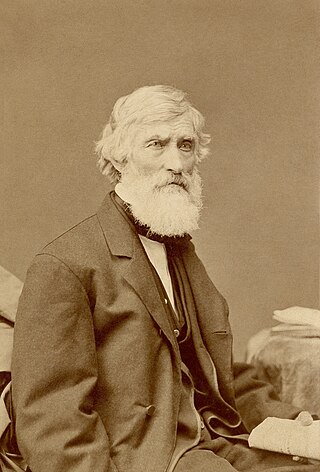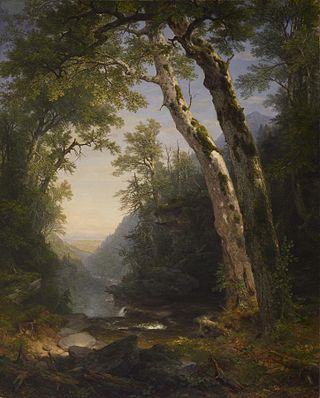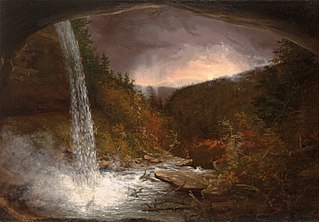
Palenville is a hamlet and census-designated place (CDP) in Greene County, New York, United States. The population was 1,002 at the 2020 census.

The Hudson River School was a mid-19th-century American art movement embodied by a group of landscape painters whose aesthetic vision was influenced by Romanticism. Early on, the paintings typically depicted the Hudson River Valley and the surrounding area, including the Catskill, Adirondack, and White Mountains.

Thomas Cole was an English-born American artist and the founder of the Hudson River School art movement. Cole is widely regarded as the first significant American landscape painter. He was known for his romantic landscape and history paintings. Influenced by European painters, but with a strong American sensibility, he was prolific throughout his career and worked primarily with oil on canvas. His paintings are typically allegoric and often depict small figures or structures set against moody and evocative natural landscapes. They are usually escapist, framing the New World as a natural eden contrasting with the smog-filled cityscapes of Industrial Revolution-era Britain, in which he grew up. His works, often seen as conservative, criticize the contemporary trends of industrialism, urbanism, and westward expansion.

Asher Brown Durand was an American painter of the Hudson River School.

Alice Louise Walton is an American heiress to the fortune of Walmart as daughter of founder Sam Walton. In September 2016, she owned over $11 billion in Walmart shares. As of November 2023, Walton has a net worth of $71 billion, making her the 17th richest person and the second-richest woman in the world according to Bloomberg Billionaires Index, after Françoise Bettencourt Meyers.

John Frederick Kensett was an American landscape painter and engraver born in Cheshire, Connecticut. He was a member of the second generation of the Hudson River School of artists. Kensett's signature works are landscape paintings of New England and New York State, whose clear light and serene surfaces celebrate transcendental qualities of nature, and are associated with Luminism. Kensett's early work owed much to the influence of Thomas Cole, but was from the outset distinguished by a preference for cooler colors and an interest in less dramatic topography, favoring restraint in both palette and composition. The work of Kensett's maturity features tranquil scenery depicted with a spare geometry, culminating in series of paintings in which coastal promontories are balanced against glass-smooth water. He was a founder of the Metropolitan Museum of Art.

Luman Reed (1787–1836) was a successful American merchant and an important patron of the arts. His support for the painters George Whiting Flagg and Thomas Cole were particularly significant contributions to the development of American painting during the early 19th century. He also commissioned works from artists such as Asher B. Durand.

Samuel Colman was an American painter, interior designer, and writer, probably best remembered for his paintings of the Hudson River.

John William Casilear was an American landscape artist belonging to the Hudson River School.

Crystal Bridges Museum of American Art is a museum of American art in Bentonville, Arkansas. The museum, founded by Alice Walton and designed by Moshe Safdie, officially opened on 11 November 2011. It offers free public admission.
Events from the year 1849 in art.

Thomas Prichard Rossiter (1818–1871) was an American artist born in New Haven, Connecticut. Known for his portraits and paintings of historical scenes, he later came to be associated with the Hudson River School of artists.

Kaaterskill Falls is a two-stage waterfall on Spruce Creek in the eastern Catskill Mountains of New York, between the hamlets of Haines Falls and Palenville in Greene County. The two cascades total 260 feet in height, making Kaaterskill Falls one of the highest waterfalls in New York, and one of the Eastern United States' tallest waterfalls.
The Knickerbocker Group was a somewhat indistinct group of 19th-century American writers. Its most prominent members included Washington Irving, James Fenimore Cooper and William Cullen Bryant. Each was a pioneer in general literature—novels, poetry and journalism. Humorously titled after Irving's own pen name, many others later joined the club. These include James Kirke Paulding, Fitz-Greene Halleck, Joseph Rodman Drake, Robert Charles Sands, Lydia Maria Child, Gulian Crommelin Verplanck, and Nathaniel Parker Willis, most of whom were also frequent contributors to the literary magazine The Knickerbocker.

Kaaterskill Clove is a deep gorge, or valley, in New York's eastern Catskill Mountains, lying just west of the village of Palenville and in Haines Falls. The clove was formed by Kaaterskill Creek, a tributary of Catskill Creek rising west of North Mountain, and is estimated by geologists to be as much as 1 million years old. Kaaterskill High Peak and Roundtop Mountain rise to the south of the gorge, while South Mountain is to its north. This makes the gorge as deep as 2,500 feet in places.

The Catskills by Asher Brown Durand, an American engraver, portraitist, and landscape artist, was commissioned by William Thompson Walters in 1858.

George Henry Hall (1825–1913) was an American still-life and landscape artist. He studied art in Düsseldorf and Paris and he worked and lived in New York City, the Catskills of New York and in Europe. His works are in museum collections in the United States and Europe. Over the course of his career he sold 1,659 paintings.

Jonathan Sturges was an American businessman, arts patron, and philanthropist.

Kaaterskill Falls is an 1826 oil-on-canvas painting by British-American painter Thomas Cole, founder of the Hudson River School. It depicts the Kaaterskill Falls in Upstate New York.
Jesse Talbot was an American landscape painter and a friend of the poet Walt Whitman. Born in Dighton, Massachusetts, Talbot worked for the American Tract Society and other evangelical Christian organizations in New York City before becoming a professional artist, first exhibiting in the National Academy of Design in 1838. His work was often favorably compared to that of Thomas Cole and other leaders of the Hudson River School of American landscape painters. Talbot developed a friendship with Walt Whitman in the 1850s. The notebook in which Whitman first wrote down the ideas for Leaves of Grass is known as the “Talbot Wilson notebook” because Talbot’s name and address are written on the inside front cover. Talbot died in relative obscurity in 1879.

















